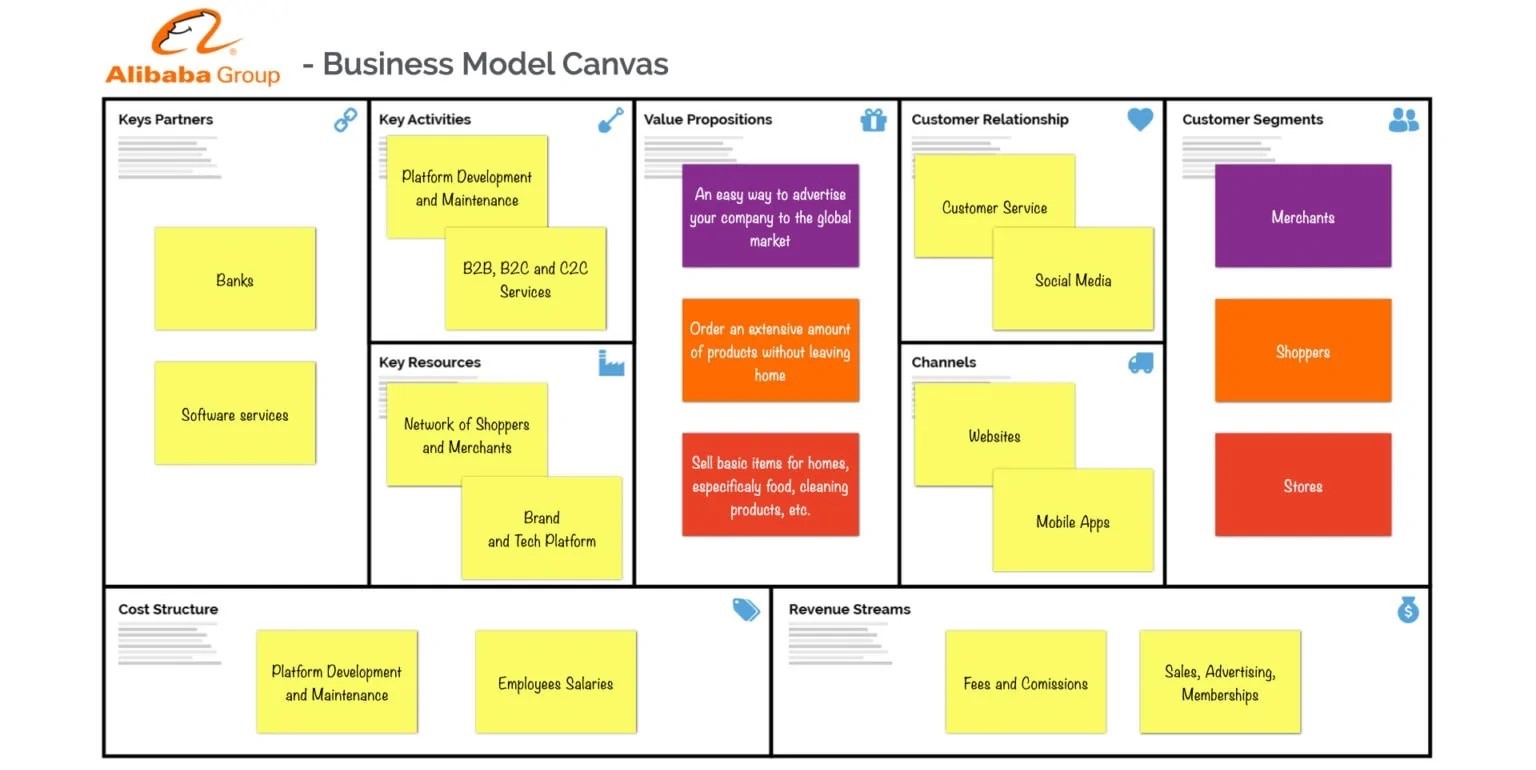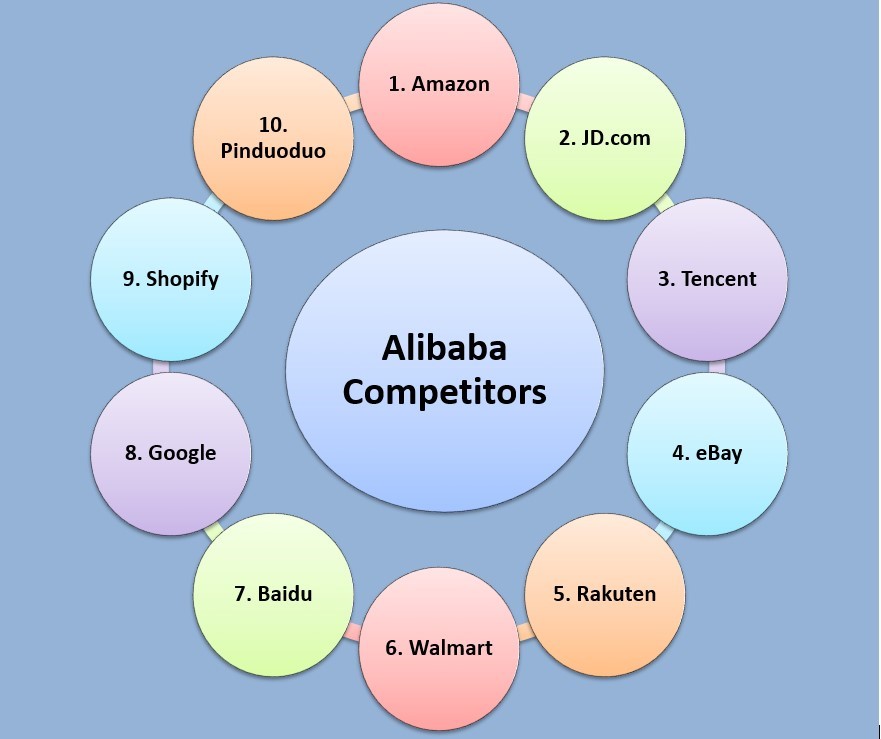
Alibaba Case Study
Introduction:
Alibaba Group has emerged as a formidable force in the realm of e-commerce. Founded in 1999 by Jack Ma, an English teacher turned entrepreneur, the company is headquartered in Hangzhou, China. Ma’s vision was to create a platform that would empower small Chinese exporters and entrepreneurs to showcase and sell their products to a global audience.
A significant milestone in Alibaba’s journey came in 2005, when it forged a strategic partnership with Yahoo. This partnership laid the groundwork for the company’s expansion and paved the way for future growth. In 2007, Alibaba.com, an online marketing technology platform, was launched, followed by the establishment of Alibaba Cloud two years later. Another pivotal moment occurred with the acquisition of HiChina, China’s leading Internet infrastructure service provider.
In 2010, AliExpress was launched, providing exporters in China with a platform to connect with consumers worldwide. The company reached another milestone in 2014 with its IPO, marking its status as the world’s largest online commerce company. Expanding its global footprint, Alibaba established offices in Hong Kong, the USA, the UK, Taiwan, and India.
Today, Alibaba and its segment businesses operate a diverse portfolio of online marketplaces, including wholesale and retail platforms. These platforms offer a range of services, including advertising, electronic payment solutions, cloud-based computing, and network services. The company’s primary operations revolve around three key websites: Tmall, catering to China’s burgeoning middle class with branded products; Taobao, China’s premier shopping destination; and Alibaba.com, facilitating global trade between Chinese exporters and international businesses.
Alibaba’s market dominance is evident through its various platforms, including Taobao.com, which offers a wide array of products and services to Chinese consumers. Tmall.com, on the other hand, provides a premium shopping experience for brands and retailers, charging them yearly fees for access to its platform. Through its innovative business model and strategic partnerships, Alibaba has solidified its position as the world’s largest online retailer, connecting businesses and consumers on a global scale.
Juhuasuan.Com is an online platform specialising in sales and marketing, offering customers access to discounts and promotional events. It serves as a dynamic marketplace for merchants and consumers alike to engage in beneficial transactions.
1688.com stands out as a premier online wholesale marketplace in China, serving as a key channel for merchants to procure products from domestic wholesalers. It provides a vital avenue for businesses to access a wide array of goods at wholesale prices.
Alibaba Group extends its reach globally through international marketplaces such as Alibaba.com, the flagship platform established by the group. This English-language wholesale marketplace facilitates global trade, connecting millions of buyers and suppliers worldwide. Sellers on Alibaba.com can list their products for a fee, including transaction charges and subscription fees for maintaining their storefronts.
AliExpress, another international venture by Alibaba Group, functions as a global retail marketplace catering to consumers worldwide. It allows consumers to purchase directly from manufacturers in China, offering a diverse range of products at competitive prices.
Alibaba’s cloud computing segment plays a crucial role in its overall strategy, providing cloud computing services to sellers on its marketplaces as well as third-party customers. The company aims to bolster its cloud computing business to surpass Amazon, not only in cloud storage services but across all sectors where Amazon holds a competitive edge. This ambitious goal underscores Alibaba’s determination to establish a formidable presence in the global market.
The name
Although the company’s name has a rich backstory, its website offers a concise explanation, stating that “Alibaba” is a well-known and easily pronounceable name. The inspiration for the name comes from the story “Ali Baba and the Forty Thieves” from “One Thousand and One Nights,” where a chamber of treasures is unlocked with the phrase “Open sesame.”
The website emphasises the global nature of e-commerce, highlighting the need for a name that is universally recognized. According to the website, “Alibaba” evokes the idea of unlocking opportunities for small businesses, akin to the magical phrase “open sesame” opening a doorway to fortune.
However, the detailed account of how the name was chosen dates back to 2006 when Jack Ma, the former English teacher turned entrepreneur, explained the process in a San Francisco coffee shop. He recounted asking a waitress if she knew about Alibaba, to which she replied with the phrase “Open Sesame.” This response resonated with Ma, who then asked various people on the street, including individuals from India, Germany, Tokyo, and China, if they were familiar with Alibaba. The widespread recognition of the name confirmed his choice.
Ma emphasised that “Alibaba” symbolises a benevolent and intelligent business figure from the story, contrary to the negative connotations associated with the “40 thieves” in the tale. He underscored the simplicity and global appeal of the name, highlighting its association with opening doors of opportunity for small to medium-sized companies. Additionally, Ma mentioned registering the name “AliMama” as a backup option, humorously suggesting it as a potential marriage partner for Alibaba.
Products of Alibaba
Alibaba holds its position in the market by selling the following –
- E-commerce
- Cloud computing
- Artificial intelligence
- Entertainment
- Mobile commerce
- Retail
- Mobile media
- Films
- TV shows

How Alibaba Plans To Take Marketing share in India
According to projections by eMarketer, e-commerce sales in India are poised for significant expansion, forecasted to surge from $14 billion in 2015 to a staggering $55 billion by 2018. India’s retail e-commerce sector witnessed remarkable growth rates of 134% in 2014 and 129.5% in 2015, positioning it as the fastest-growing nation in the Asia Pacific region for retail e-commerce. Despite this rapid growth, online retail presently constitutes only about 0.8% of total retail sales in India, a stark comparison to the global average of 6.3%.
However, there’s substantial room for growth, with projections indicating that online retail’s share could climb to 4.8% by 2019. This presents a lucrative opportunity in a market that is still in its nascent stages compared to global standards. With Amazon already making significant strides in India, Alibaba is now focusing on strengthening its foothold in the country, recognizing the immense potential it holds.
With The Flipkart Deal, Alibaba Will Hold Stake In The Top Two Ecommerce Players In India
Snapdeal and Flipkart collectively dominate nearly three-quarters of the e-commerce market share in India. Should Alibaba acquire a stake in Flipkart, it would position itself strongly in the country’s e-commerce landscape by holding significant shares in both these key players. This move could potentially pave the way for a formidable coalition against Amazon, the global e-commerce giant.
Alibaba regards India as its second-largest market after China and aims to onboard 10 million Indian businesses onto its B2B platform in the coming years, while simultaneously expanding its reach among retail consumers.
We anticipate that as businesses seek to capitalise on India’s burgeoning e-commerce sector, Alibaba’s strategic investments in leading players within the region will allow it to establish a formidable presence in the country. This, in turn, could intensify competition for Amazon in the Indian market.
The rise of e-commerce has transformed the business landscape, with Alibaba emerging as a powerhouse in this realm. Originating in 1999 from a modest apartment in Hangzhou, Alibaba, under the leadership of Jack Ma, began its journey with Alibaba.com, a global wholesale marketplace connecting buyers and sellers. Over time, it expanded its portfolio to include Taobao, a C2C e-commerce platform, and Tmall, a B2C retail platform.
Alibaba.com facilitates billions of dollars in transactions annually, serving as a vital link between mainland China and global markets. Despite its B2B focus, Alibaba faced numerous challenges on its path to growth. Jack Ma’s entrepreneurial journey began at a young age, instilling in him a resilient and innovative mindset.
From humble beginnings and overcoming adversities, Alibaba has emerged as a trailblazer in B2B commerce, poised to revolutionise the industry.
Concentration lies at the heart of Alibaba’s B2B strategy.
Alibaba’s rapid ascent can be credited to its emphasis on expanding its vast network of suppliers, particularly targeting Chinese and other Asian sellers not typically reached by platforms like Amazon.
Essentially, Alibaba’s B2B marketplace serves as a conduit to China and its burgeoning economy, which boasts a significant capacity for producing sought-after goods worldwide.
In response to the global appetite for its products, Alibaba prioritises building trust by implementing measures such as business verification, factory inspections, and stringent quality standards, thereby widening its reach and enhancing its global presence.
Alibaba & The Future of B2B eCommerce
Alibaba represents just the initial phase of the future trajectory of B2B eCommerce. There remains ample room for eCommerce platforms, wholesalers, distributors, and retailers to address inefficiencies in supply chains, paper-based processes, and error-prone workflows.
There are widespread opportunities for:
- Embracing and implementing modern technologies like matching algorithms, intuitive user experiences, personalization, and leveraging big data.
- Emphasizing mobile transactions, considering that nearly half of China’s retail eCommerce sales occur via mobile devices. Prioritising mobile B2B eCommerce involves transitioning from face-to-face transactions to mobile order processing, seamless integration between order management and enterprise resource planning systems, and adopting mobile-first workflows.
- Differentiating from Alibaba’s expansive marketplace model by adopting more targeted direct models that foster stronger relationships between suppliers/brands and customers/retail buyers.
Alibaba’s B2B approach has also spawned opportunities for wholesalers and distributors. Some wholesalers and manufacturers may find it advantageous to leverage Alibaba’s resources to access global marketplaces worldwide.
Alibaba’s Business Model Canvas
Let’s take a look at the Alibaba Business Model Canvas below:

Alibaba’s Customer Segment
Alibaba’s customer base encompasses three main segments:
- Merchants: This group includes Chinese businesses and merchants seeking to showcase their products to both domestic and international markets. Alibaba provides a platform for these merchants to advertise and sell their goods.
- Shoppers: These are individuals who prefer the convenience of shopping from their homes rather than traditional brick-and-mortar stores. Additionally, manufacturers seeking suppliers for raw materials also fall under this category, as they utilise Alibaba’s platform to connect with potential suppliers.
- Stores: Alibaba operates a supermarket chain called Hemma, offering a wide range of products including food, groceries, tools, and beverages. This segment caters to consumers seeking a one-stop-shop for their everyday needs, similar to a traditional supermarket.
Alibaba’s Value Propositions
Alibaba offers compelling value propositions tailored to its different customer segments:
- Merchants: Alibaba provides a straightforward avenue for companies to promote their businesses to a worldwide audience, facilitating increased demand and profitability.
- Shoppers: For consumers, Alibaba offers the convenience of accessing a vast array of products from the comfort of their homes, without the need to physically visit China.
- Stores: Through its supermarket chain and delivery services, Alibaba caters to individuals seeking essential household items such as food, cleaning products, and other everyday goods, providing convenience and accessibility.
Alibaba’s Channels
Alibaba’s channels consist of:
- Websites
- Through apps for Android and iOS platforms
Alibaba’s Customer Relationships
Alibaba’s customer relationships consist of:
- Social media
- Users’ channels
- Q&A
- Telephones
Alibaba’s Revenue Streams
Alibaba’s revenue streams consist of:
- Fees
- Membership programs
- Advertising
- Commissions
- Sales
Alibaba’s Key Resources
Alibaba’s key resources consist of:
- Network of shoppers and merchants
- Brand
- Technology platform
Alibaba’s Key Activities
Alibaba’s key activities consist of:
- Business to business services (B2B)
- Consumer to consumer services (C2C)
- Business to consumer services (B2C)
- Retail
- E-commerce
- Supermarkets
- Payment services
- Cloud computing
- Search engine
Alibaba’s Key Partners
Alibaba’s key partners consist of:
- Small businesses of all kinds
- Medium-large manufacturers
- Tech companies
- Banks
- IT services
- Software companies
- Shoppers
Alibaba’s Cost Structure
Alibaba’s cost structure consists of:
- Salaries
- Bonus payments
- Marketing
- Taxes
- Legal fees
- General maintenance
- Development programs
- Training
- Structures
- Investments
- Administrative and legal departments
SWOT Analysis Of Alibaba
Strengths of Alibaba
Strengths are the defining attributes that set a company apart from its competitors. These may include a skilled and knowledgeable workforce, tangible assets such as intellectual property, capital reserves, and advanced technology.
- Alibaba, a prominent player in the online retail sector, boasts several strengths that have contributed to its extraordinary success. Notably, the company achieved the largest initial public offering (IPO) in history in 2014, valued at a staggering US$231 billion. Additionally, in 2020, Alibaba was recognized as the fifth-largest AI company globally. Its dominance across various market segments, including B2B, B2C, and C2C, has further bolstered its position in the industry.
- Alibaba’s robust investment in research and development (R&D) serves as a key strength, enabling the company to stay ahead of the competition. With significant R&D centres located in Hangzhou, Beijing, Hong Kong, Singapore, Silicon Valley, and Dubai, Alibaba continues to innovate and drive its success forward.
- The COVID-19 pandemic presented challenges for many businesses, but Alibaba thrived in this environment, experiencing a remarkable 30% growth in 2020 as consumers increasingly turned to online shopping. The company’s adaptability and operational efficiency played a pivotal role in navigating these unprecedented circumstances and maintaining its upward trajectory.
Weaknesses of Alibaba
Weaknesses are areas where a company lacks strength or faces challenges. In the case of Alibaba, several weaknesses have been identified through SWOT analysis:
- Limited International Presence: While Alibaba enjoys strong market share and dominance in China, its presence in international markets is comparatively limited. This reliance on the Chinese market exposes the company to risks associated with geopolitical factors and regional economic fluctuations.
- Heavy Dependence on E-commerce: Alibaba’s revenue is heavily reliant on e-commerce, which poses a limitation in terms of diversification. If the e-commerce sector experiences downturns or disruptions, Alibaba may struggle to maintain its business scale without robust backup options.
- Counterfeit Product Issues: Alibaba faces challenges with counterfeit products being sold on its platforms, which can negatively impact its reputation and undermine customer trust. The presence of counterfeit items not only raises concerns about the authenticity of products but also exposes Alibaba to potential legal and regulatory issues. Addressing this issue is crucial for safeguarding the company’s credibility and ensuring customer satisfaction.
Opportunities for Alibaba
Opportunities arise when there is a growing demand for a specific product or when positive media coverage enhances brand visibility.
- Alibaba’s weakness in international expansion presents a significant opportunity for growth. With its extensive resources and infrastructure, Alibaba has the capacity to broaden its presence across multiple regions, positioning itself as the foremost global e-commerce platform, outperforming its competitors.
- Furthermore, Alibaba’s cloud computing division holds immense potential to capture a substantial share of the market. Given the vast amount of data generated by Chinese internet users, Alibaba can capitalize on this opportunity by offering a secure platform for data storage and integration. This would not only facilitate expansion but also enable Alibaba to harness the valuable insights derived from the data for various strategic initiatives.

Threats to Alibaba
Threats arise from various factors such as the emergence of new competitors, shifts in regulatory landscapes, negative media coverage, and customer loyalty changes.
- For Alibaba, geopolitical tensions and trade conflicts have posed challenges to its international business endeavours and global market expansion efforts. Additionally, economic uncertainties have resulted in decreased consumer spending, impacting Alibaba’s e-commerce sales and overall revenue streams. Furthermore, heightened online activity has intensified competition, posing a threat to Alibaba’s market dominance and necessitating continuous innovation to maintain its competitive edge.
- Despite these challenges, Alibaba has also experienced benefits amidst the pandemic, with increased demand for online shopping and cloud computing services. These trends have helped offset some of the adverse effects, highlighting Alibaba’s resilience and adaptability in navigating challenging environments.
Alibaba’s Competitors
Amazon: A top-tier technology giant in the United States and one of the largest retail corporations globally. Known for its fiercely competitive culture, substantial financial resources, and considerable influence, Amazon maintains a competitive edge when pitted against its primary rivals.
eBay: A trailblazer in establishing the model for online C2C marketplaces. Renowned for its efficient delivery system and user-friendly website design, eBay prioritises enhancing user experience for its customers.
Walmart: Ranked as the second-largest retail company in the United States, following closely behind Amazon. Boasting an appealing membership program and a dedicated consumer base, Walmart has established itself as a formidable competitor in the retail sector.
Tencent: Among Asia’s most valuable companies, Tencent achieved the remarkable milestone of surpassing a market value of US$500 billion. Positioned as a formidable player in the IT and technology domains, Tencent poses a significant threat to Alibaba Group’s business operations. Its widespread popularity in China, coupled with its substantial economic and political influence, further solidify its competitive stance against Alibaba Group.

Conclusion
Alibaba has solidified its position in the e-commerce industry through its expansive operations, inventive approaches, effective distribution methods, and significant market share. Despite challenges such as the presence of counterfeit products and heavy reliance on the Chinese market, Alibaba remains a favoured choice among consumers worldwide. Given China’s status as the world’s second most populous country, it serves as Alibaba’s primary revenue source.
By leveraging a robust digital marketing strategy, Alibaba can extend its reach to diverse global markets while capitalising on the cost-efficiency offered by digital channels. This includes utilising various avenues such as search engine optimization (SEO), email marketing, content marketing, and social media marketing to enhance brand visibility and engage with target audiences effectively.







